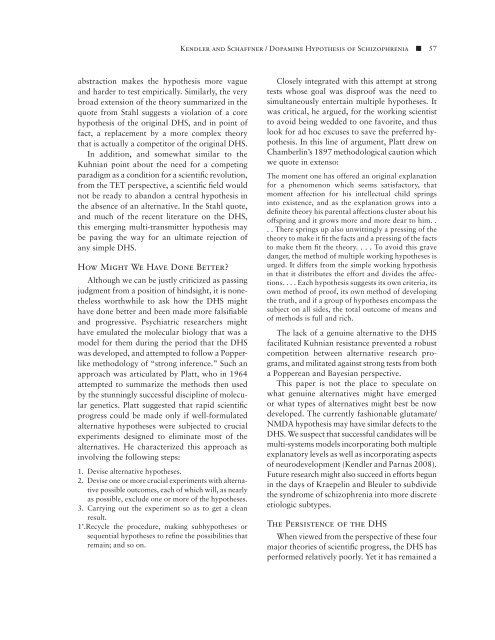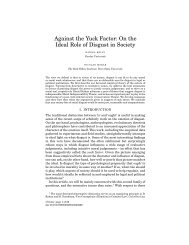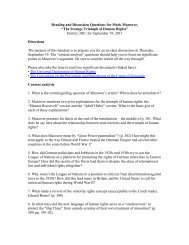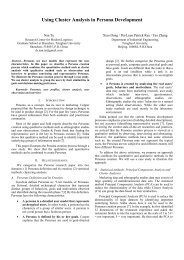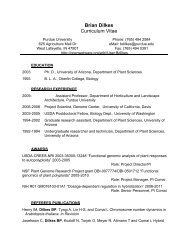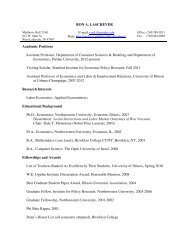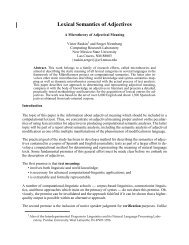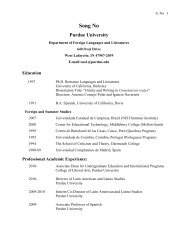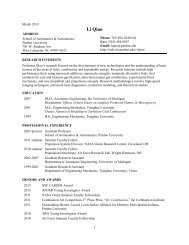The Dopamine Hypothesis of Schizophrenia: An Historical and ...
The Dopamine Hypothesis of Schizophrenia: An Historical and ...
The Dopamine Hypothesis of Schizophrenia: An Historical and ...
You also want an ePaper? Increase the reach of your titles
YUMPU automatically turns print PDFs into web optimized ePapers that Google loves.
Kendler <strong>and</strong> Schaffner / <strong>Dopamine</strong> <strong>Hypothesis</strong> <strong>of</strong> <strong>Schizophrenia</strong> ■ 57<br />
abstraction makes the hypothesis more vague<br />
<strong>and</strong> harder to test empirically. Similarly, the very<br />
broad extension <strong>of</strong> the theory summarized in the<br />
quote from Stahl suggests a violation <strong>of</strong> a core<br />
hypothesis <strong>of</strong> the original DHS, <strong>and</strong> in point <strong>of</strong><br />
fact, a replacement by a more complex theory<br />
that is actually a competitor <strong>of</strong> the original DHS.<br />
In addition, <strong>and</strong> somewhat similar to the<br />
Kuhnian point about the need for a competing<br />
paradigm as a condition for a scientific revolution,<br />
from the TET perspective, a scientific field would<br />
not be ready to ab<strong>and</strong>on a central hypothesis in<br />
the absence <strong>of</strong> an alternative. In the Stahl quote,<br />
<strong>and</strong> much <strong>of</strong> the recent literature on the DHS,<br />
this emerging multi-transmitter hypothesis may<br />
be paving the way for an ultimate rejection <strong>of</strong><br />
any simple DHS.<br />
How Might We Have Done Better?<br />
Although we can be justly criticized as passing<br />
judgment from a position <strong>of</strong> hindsight, it is nonetheless<br />
worthwhile to ask how the DHS might<br />
have done better <strong>and</strong> been made more falsifiable<br />
<strong>and</strong> progressive. Psychiatric researchers might<br />
have emulated the molecular biology that was a<br />
model for them during the period that the DHS<br />
was developed, <strong>and</strong> attempted to follow a Popperlike<br />
methodology <strong>of</strong> “strong inference.” Such an<br />
approach was articulated by Platt, who in 1964<br />
attempted to summarize the methods then used<br />
by the stunningly successful discipline <strong>of</strong> molecular<br />
genetics. Platt suggested that rapid scientific<br />
progress could be made only if well-formulated<br />
alternative hypotheses were subjected to crucial<br />
experiments designed to eliminate most <strong>of</strong> the<br />
alternatives. He characterized this approach as<br />
involving the following steps:<br />
1. Devise alternative hypotheses.<br />
2. Devise one or more crucial experiments with alternative<br />
possible outcomes, each <strong>of</strong> which will, as nearly<br />
as possible, exclude one or more <strong>of</strong> the hypotheses.<br />
3. Carrying out the experiment so as to get a clean<br />
result.<br />
1’.Recycle the procedure, making subhypotheses or<br />
sequential hypotheses to refine the possibilities that<br />
remain; <strong>and</strong> so on.<br />
Closely integrated with this attempt at strong<br />
tests whose goal was dispro<strong>of</strong> was the need to<br />
simultaneously entertain multiple hypotheses. It<br />
was critical, he argued, for the working scientist<br />
to avoid being wedded to one favorite, <strong>and</strong> thus<br />
look for ad hoc excuses to save the preferred hypothesis.<br />
In this line <strong>of</strong> argument, Platt drew on<br />
Chamberlin’s 1897 methodological caution which<br />
we quote in extenso:<br />
<strong>The</strong> moment one has <strong>of</strong>fered an original explanation<br />
for a phenomenon which seems satisfactory, that<br />
moment affection for his intellectual child springs<br />
into existence, <strong>and</strong> as the explanation grows into a<br />
definite theory his parental affections cluster about his<br />
<strong>of</strong>fspring <strong>and</strong> it grows more <strong>and</strong> more dear to him. .<br />
. . <strong>The</strong>re springs up also unwittingly a pressing <strong>of</strong> the<br />
theory to make it fit the facts <strong>and</strong> a pressing <strong>of</strong> the facts<br />
to make them fit the theory. . . . To avoid this grave<br />
danger, the method <strong>of</strong> multiple working hypotheses is<br />
urged. It differs from the simple working hypothesis<br />
in that it distributes the effort <strong>and</strong> divides the affections.<br />
. . . Each hypothesis suggests its own criteria, its<br />
own method <strong>of</strong> pro<strong>of</strong>, its own method <strong>of</strong> developing<br />
the truth, <strong>and</strong> if a group <strong>of</strong> hypotheses encompass the<br />
subject on all sides, the total outcome <strong>of</strong> means <strong>and</strong><br />
<strong>of</strong> methods is full <strong>and</strong> rich.<br />
<strong>The</strong> lack <strong>of</strong> a genuine alternative to the DHS<br />
facilitated Kuhnian resistance prevented a robust<br />
competition between alternative research programs,<br />
<strong>and</strong> militated against strong tests from both<br />
a Popperean <strong>and</strong> Bayesian perspective.<br />
This paper is not the place to speculate on<br />
what genuine alternatives might have emerged<br />
or what types <strong>of</strong> alternatives might best be now<br />
developed. <strong>The</strong> currently fashionable glutamate/<br />
NMDA hypothesis may have similar defects to the<br />
DHS. We suspect that successful c<strong>and</strong>idates will be<br />
multi-systems models incorporating both multiple<br />
explanatory levels as well as incorporating aspects<br />
<strong>of</strong> neurodevelopment (Kendler <strong>and</strong> Parnas 2008).<br />
Future research might also succeed in efforts begun<br />
in the days <strong>of</strong> Kraepelin <strong>and</strong> Bleuler to subdivide<br />
the syndrome <strong>of</strong> schizophrenia into more discrete<br />
etiologic subtypes.<br />
<strong>The</strong> Persistence <strong>of</strong> the DHS<br />
When viewed from the perspective <strong>of</strong> these four<br />
major theories <strong>of</strong> scientific progress, the DHS has<br />
performed relatively poorly. Yet it has remained a


